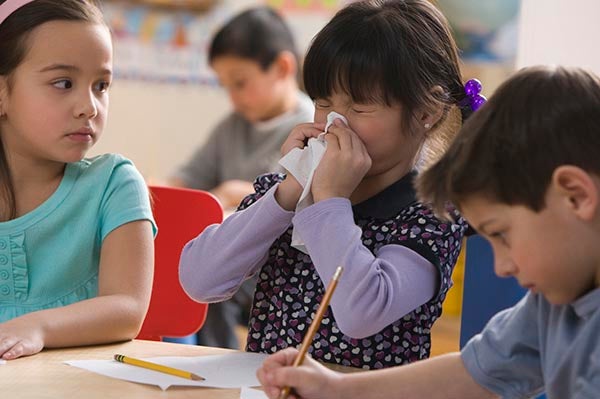 The beginning of each new school year brings with it the usual sights and sounds, from children catching up with friends after a long summer break to the rustle of recently purchased notebooks, ready to be filled with new knowledge. Amongst this energy and anticipation, a faint sniffle or cough may also be heard, marking the start of back-to-school sickness for students and teachers alike.
The beginning of each new school year brings with it the usual sights and sounds, from children catching up with friends after a long summer break to the rustle of recently purchased notebooks, ready to be filled with new knowledge. Amongst this energy and anticipation, a faint sniffle or cough may also be heard, marking the start of back-to-school sickness for students and teachers alike.
According to Alexandra Filonenko, CRNP, a Trinity Health Mid-Atlantic Medical Group family medicine provider at Primary Care Woodbourne in Levittown, a combination of factors causes respiratory illnesses to run rampant in classrooms every fall.
“Over the summer, we all go elsewhere, and so we bring back these new bacteria from all the places that we visited. Then there’s the weather changes, shifting from the summer, when it’s nice and warm, to the fall, when it starts getting a little cooler. Kids go from being mostly outdoors to indoors, which is enough to cause sickness,” says Filonenko. “Plus, flu season is just beginning, but we don’t start giving out flu shots until the end of September or mid-October, so many people aren’t vaccinated just yet at the start of school.”
Symptoms of respiratory illness include a cough, sore throat and generalized fatigue, all of which comes on rapidly. This differs from seasonal allergies, which typically involve more subtle symptoms such as postnasal drip, eye tearing and puffiness in the eyes and face.
Due to their immature immunity systems, children tend to feel these symptoms more severely than adults. However, Filonenko warns that new teachers may get sicker than their experienced counterparts as they come into contact with—and adapt to—mutated bacteria and viruses that cause respiratory symptoms.
“Teachers are a very resilient group because they work with children all the time. But I do know that teachers who are just starting out, it takes some time to build that immunity. Several of my friends who are teachers told me, ‘The first two years of school, I was sick all the time’,” says Filonenko. “They are not immune to the viruses that children are now getting because the viruses are not the same [as when they were children]. The new teachers have to get used to this new generation of germs.”
Reducing the risk of illness
If a student is sick, there are precautions that can be taken to prevent—or at least reduce—the spread of the illness. These include frequent hand washing, coughing into the elbow, keeping windows open (weather permitting) to ensure air circulation in the classroom and regular cleaning of the space.
Still, adds Filonenko, the best way to avoid a class-wide illness is for parents and guardians to keep a child home from school if they are sick, especially if they have a fever. While recovering at home, the same precautions should be followed—frequent hand washing with soap and water, covering coughs and air circulation—to avoid spreading the illness to parents and siblings.
“Additionally, when children are sick and they stay home, it doesn’t mean that they have to actually lay down in bed all day. Obviously, during the acute stage when they have a fever, they should lay down. But then once they’re a bit better, it’s beneficial to take them out,” says Filonenko. “Perhaps they won’t be playing as actively as they normally would, but fresh air and sunlight exposure does them good. There is no reason for them to stay home the entire time they have a respiratory illness.”
In the weeks leading up to the start of school, there are a few things that parents can do to boost their child’s immunity, thus reducing the risk of illness when they return to the classroom. Lots of fresh air, a balanced diet (fruits, vegetables, Vitamin C, protein and iron-rich foods) and regular exercise, whether it be sports or simply riding a bike around the neighborhood, can all be beneficial.
“I would definitely say, the better the diet, the better the immunity will be,” says Filonenko. “I can’t say that obesity affects immunity, but it affects the cardiovascular system. It affects your breathing, which in turn could affect your ability to effectively fight respiratory illnesses. So, the healthier you are, the healthier your weight is, the better you will be in coping with whatever illness you have, respiratory included.”
Visit Primary Care at St. Mary for more information and to schedule a primary care appointment at one of St. Mary Medical Center’s seven locations.
